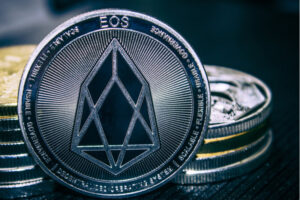The Future of These Brave New Virtual Worlds
7 min read
Until ten years ago, entering an immersive virtual world sounded like something out of a fantasy novel or a 90s sci-fi film.
But today, players are given a whole new gaming experience with the introduction of virtual reality (VR) and even artificial intelligence (AI).
What makes metaverse gaming so compelling, and where is it headed in the near future? We speak to industry leaders and offer our own thoughts on these brave new virtual worlds.
What Is So Attractive About Metaverse Gaming?
The video game industry is one of the most dominating entertainment industries out there, with revenue forecast to grow continuously in the coming years and estimated to reach $533 billion by 2027.
Another industry taking the world by storm is the cryptocurrency market, with the total market capitalization of cryptocurrencies surpassing $1 trillion. So what happens when you merge the two together?
Metaverse games are immersive virtual worlds where players can interact and socialize with one another and create and trade assets. However, and most importantly, players can also claim full ownership over their game assets.
Sebastien Borget, the co-founder and COO of The Sandbox, one of the biggest play-to-earn metaverse games, told Technopedia: “For players, creators, and any individual, there is the benefit of full ownership of digital assets, and full authorship of any of their creations — in addition to the entertainment factor that comes from new forms of social interactions and gameplay.”
He added that metaverse games are about “unleashing creativity and individual’s expression without boundaries, not about getting an immediate payoff.”
Karl Blomsterwall, the CEO of Planet IX, a strategy game powered by non-fungible tokens (NFT), added that the metaverse and Web3 gaming space have opened a wealth of opportunities for crypto investors.
“Unlike traditional gaming, where in-game assets are confined to the virtual world, Web3 and metaverse gaming introduce the concept of non-fungible tokens. Because these NFTs represent digital assets that players can own and trade, they create the potential to allow gaming communities to earn real-world money. The concept of true ownership will certainly play a big role in our digital future and gaming will be one of the biggest industries to leverage this.”
Market Cap on Metaverse Gaming Loses Streak
Although the overall market capitalization for the metaverse gaming industry has been going through a bear run these past few months, Blomsterwall reassured that this is a “natural process” the industry must go through to emerge stronger.
According to data collected in the first quarter of 2023 by dApp Radar, blockchain gaming activity saw an 8.58% decrease in Q1 2023 compared to the previous quarter. In the meantime, investment in blockchain games has also declined compared to Q3 2022, down to $739 million from a previous $1.22 billion achievement.
Despite the drop, Planet IX had managed to come ahead as a winner, with dAppRadar noting it has been one of the top five games of Q1 2023.
“The ones who will be the big leaders when sentiment changes are the ones building during these times of lesser activity and decline. I strongly believe in the potential of the Web3 gaming world and that we will witness very strong growth in the area as the cryptocurrency market sentiments change, as well as stabilize and mature,” Blomsterwall added.
The CEO and co-founder, Ayelen Denovitzer, of the gaming start-up Qubit, added that while some industries, such as AI, are currently coming out as winners, others are not as successful. Denovitzer explained that one of the reasons why Web3 games may not be doing as well is because the space is not ready yet for mass adoption.
The Sandbox’s Borget added:
“We see the tokens of metaverse gaming as a new asset class and just like traditional assets, holding onto it, revenue can generate over the mid-to-long term more than on a short-term basis. The markets have not been favourable neither for traditional assets – ups and downs are to be expected, especially in a new sector. We see an inflow of talents in the space and we are confident on the long-term potential of the metaverse as a new platform for entertainment, social interaction, and creative enterprises.”
Regulatory Challenges and Metaverse Gaming
At the start of June 2023, the US Securities and Exchange Commission (SEC) filed charges against 13 Binance entities as well as the company’s founder Changpeng Zhao, targeting cryptocurrencies that are securities, essentially also including The Sandbox’s native token SAND and Decentraland’s MANA coin into the mix.
This turn of events has sparked worry in the industry about where metaverse gaming could be headed next regarding regulatory challenges.
The Sandbox’s Borget told Technopedia that while the company can not comment directly on how such regulations could impact its future, he stated that “regulatory bodies are essential in defining the boundaries and frameworks” of the landscape of metaverse games.
Planet IX’s Blomsterwall added that several global governments are taking strides to help support innovation within the industry.
“We’re also seeing industry stakeholders actively engaged in discussions with governments and regulators to build frameworks that strike a balance between addressing these concerns and promoting innovation in this sector. I believe that this ongoing collaboration will play a huge role in overcoming these challenges.”
Meanwhile, Qubit’s Denovitzer added that measures such as the European Union’s Markets in Crypto Assets (MiCA) regulation have been helpful and constructive for all metaverse and crypto space projects.
“Establishing a clear regulatory framework provides a solid foundation for the growth and development of the ecosystem as a whole.”
Big Corporation Entering the Metaverse
Big corporations, including companies like Meta and Google, have expressed interest in wanting to enter the metaverse. However, one of the biggest challenges companies may face while attempting to tackle this fascinating space is how they adapt to a new and changing digital world.
This would mean that larger companies would need to shift their ways of working towards a more decentralized system, which metaverse and Web3 games are based on, Planet IX’s Blomsterwall noted.
“The Web3 gaming landscape is also dependent on true ownership and the opportunity for players to take part in in-game economies. The digital future of gaming is more inclusive. The flow won’t mainly be from gaming studios to the players, it will be a more symbiotic relationship. There’s a ton of great opportunities in this, as of course challenges.”
The Sandbox has been a prominent name in the metaverse gaming industry for partnerships, as the platform has collaborated with over 400 global brands in the fashion, art, and sports industries.
“The main challenge for big corporations is to understand that there is more to the metaverse than a pure advertising play and a quick cash grab opportunity, hence attracting the right talents. Each brand should seek to find its voice while achieving its goals, whether this is awareness, education, brand building, consumer acquisition, and engagement, or, as typically is the case, a mix of the above,” The Sandbox’s Borget noted.
The Future of Metaverse Gaming Space
Borget is positive that, in the long run, the metaverse gaming space will only continue to grow.
“We are seeing the tools, the craft, and the creative possibilities grow on a weekly, monthly, and yearly basis. I cannot wait to see new multiplayer game types, game mechanics, and methods to (re)create social interaction and new ways to express your digital identity. I’m as excited today as I was when we first announced The Sandbox.”
Gen Z spends more time engaging with video games than watching TV as Gen Z consumers spend an average of over 12 hours a week on video games, a report by Newzoo revealed. In addition to the growing popularity of the metaverse gaming space, this could be a great recipe for potential success.
Blomsterwall added that he anticipates more convergence between Web2 and Web3 worlds “as big corporations enter the space and as blockchain-based platforms become more accessible to traditional audiences.”
Qubit’s Denovitzer added that in order for the metaverse gaming space to be ready for potential success, the industry must be prepared in advance.
“For this to happen, and for ‘the next billion users’ to join the space, we need to ensure the Web3/metaverse gaming is ready. This entails focusing on enhancing user experience, providing secure non-custodial wallets for seamless management of digital assets, and prioritizing user education. We need to make sure the gamers are ready to enter the metaverse and Web3 and that the metaverse and Web3 are also ready for them.”
The Bottom Line
Despite recent market fluctuations and regulatory challenges, the metaverse gaming industry is poised for long-term growth. The fusion of crypto technology with gaming has unlocked new opportunities, offering players true ownership of digital assets and the potential to earn real-world income through non-fungible tokens.
While more giant corporations express interest in this space, adapting to decentralization remains challenging. Nevertheless, the continued evolution of creative possibilities, increased Gen Z engagement, and the convergence of Web2 and Web3 worlds suggest a promising future for the metaverse gaming landscape, contingent on a focus on user experience, security, and education.
Source link
#Future #Brave #Virtual #Worlds






